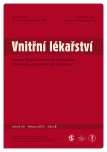Prevalence of liver disease markers among patients with metabolic risk factors
Authors:
T. Koller; J. Kollerová; T. Hlavatý; M. Huorka; J. Payer
Authors‘ workplace:
V. interná klinika Lekárskej fakulty UK a FNsP Bratislava, Slovenská republika, prednosta prof. MUDr. Juraj Payer, CSc.
Published in:
Vnitř Lék 2010; 56(3): 183-189
Category:
Original Contributions
Overview
Introduction:
Non-alcoholic fatty liver disease is one of the most common liver diseases. It’s prevalence among patients with metabolic risk factors (obesity, type 2 diabetes, hypertension, lipid disorders) without previously recognized liver disease is not completely known.
Aim:
Aims of our study were to determine the prevalence of liver lesions (elevated alanin aminotransferase (ALT), gamma glutamyl transpeptidase (GGT) above normal range and ultrasound signs of liver steatosis) among the study group of patients with at least one metabolic risk factor, to compare it with the control group with no risk factor, to investigate it’s association with the number of metabolic risk factors and to identify it’s closest independent predictors.
Methods:
Patients with other known liver diseases were excluded. Among 482 patients 429 were in the study group and 53 in the control group.
Results:
In the study group the prevalence of ALT, GGT elevation and signs of steatosis was 12.1, 29.9, 38.3 %, comparing to 5.7, 11.9 and 5.7 % in the control group respectively. The differences were statistically significant. With the increasing number of risk factors we found growing prevalence of GGT elevation and signs of steatosis, but ALT elevation was equally prevalent. In multiple logistic regression the only independent predictor of ALT elevation was obesity, predictors of GGT elevation were type 2. diabetes and signs of steatosis, signs of steatosis were independently associated with overweight, obesity, type 2 diabetes and hypertriglyceridemia.
Conclusions:
Markers of liver disease do have a clinical and prognostic impact on the liver and cardiometabolic risk and therefore we suggest they should be actively screened in this group of patients.
Key words:
prevalence – ALT – GGT – screening – steatosis – obesity – hypertension – diabetes mellitus
Sources
1. Mokáň M, Galajda P, Prídavková D et al. Prevalence of diabetes mellitus and metabolic syndrome in Slovakia. Diabetes Res Clin Pract 2008; 81 : 238 – 242.
2. Marchesini G, Bugianesi E, Forlani G et al. Nonalcoholic fatty liver, steatohepatitis, and the metabolic syndrome. Hepatology 2003; 37 : 917 – 923.
3. Hůlek P, Dresslerová I. Metabolický syndrom a játra (NAFLD/ NASH). Vnitř Lék 2009; 55 : 646 – 649.
4. Koller T. Diagnostika a manažment pacientov s nealkoholovou tukovou chorobou pečene. Čes Slov Gastroenterol Hepatol 2007; 61 : 96 – 102.
5. Argo CK, Caldwell SH. Epidemiology and natural history of non‑alcoholic steatohepatitis. Clin Liver Dis 2009; 13 : 511 – 531.
6. Ruhl CE, Everhart JE. Determinants of the association of overweight with elevated serum alanine aminotransferase activity in the United States. Gastroenterology 2003; 124 : 71 – 79.
7. André P, Balkau B, Vol S et al. DESIR Study Group. Gamma - glutamyltransferase activity and development of the metabolic syndrome. (International Diabetes Federation Definition) in middle - aged men and women: Data from the Epidemiological Study on the Insulin Resistance Syndrome (DESIR) cohort. Diabetes Care 2007; 30 : 2355 – 2361.
8. Wannamethee SG, Shaper AG, Lennon L et al. Hepatic enzymes, the metabolic syndrome, and the risk of type 2 diabetes in older men. Diabetes Care 2005; 12 : 2913 – 2918.
9. Lee DS, Evans JC, Robins SJ et al. Gammaglutamyl transferase and metabolic syndrome, cardiovascular disease, and mortality risk: the Framingham Heart Study. Arterioscler Thromb Vasc Biol 2007; 27 : 127 – 133.
10. Kang YH, Min HK, Son SM et al. The association of serum gamma glutamyltransferase with components of the metabolic syndrome in the Korean adults. Diabetes Res Clin Pract 2007; 77 : 306 – 313.
11. Browning JD. Statins and hepatic steatosis: perspectives from the Dallas Heart Study. Hepatology 2006; 44 : 466 – 471.
12. Sanyal AJ. American Gastroenterological Association. AGA technical review on nonalcoholic fatty liver disease. Gastroenterology 2002; 123 : 1705 – 1725.
13. Gupte P, Amarapurkar D, Agal S et al. Non - alcoholic steatohepatitis in type 2 diabetes mellitus. J Gastroenterol Hepatol 2004; 19 : 854 – 858.
14. Kogiso T, Moriyoshi Y, Nagahara H. Clinical significance of fatty liver associated with metabolic syndrome. Hepatol Res 2007; 37 : 711 – 721.
15. Targher G, Bertolini L, Rodella S et al. Non-alcoholic fatty liver disease is independently associated with an increased incidence of cardiovascular events in type 2 diabetic patients. Diabetes Care 2007; 30 : 2119 – 2121.
16. Hamaguchi M, Kojima T, Takeda N et al. Nonalcoholic fatty liver disease is a novel predictor of cardiovascular disease. World J Gastroenterol 2007; 13 : 1579 – 1584.
17. Siegel AB, Zhu AX. Metabolic syndrome and hepatocellular carcinoma: two growing epidemics with a potential link. Cancer 2009; 115 : 5651 – 5661.
18. Angulo P. Noninvasive assessment of fibrosis and steatosis in NASH and ASH. Gastroenterol Clin Biol 2009; 33 : 940 – 948.
19. Vuppalanchi R, Chalasani N. Nonalcoholic fatty liver disease and nonalcoholic steatohepatitis: Selected practical issues in their evaluation and management. Hepatology 2009; 49 : 306 – 317.
Labels
Diabetology Endocrinology Internal medicineArticle was published in
Internal Medicine

2010 Issue 3
Most read in this issue
- Contribution to differential diagnosis of chronic abdominal pain
- Persisting symptoms, diastolic dysfunction and decreased coronary flow reserve after succesful correction of aortic recoarctation
- Treatment of adult acute lymphoblastic leukemia according to GMALL 07/ 2003 study protocol in the Czech Republic – the first experience
- Non-alcoholic steatosis and steatohepatitis – editorial
